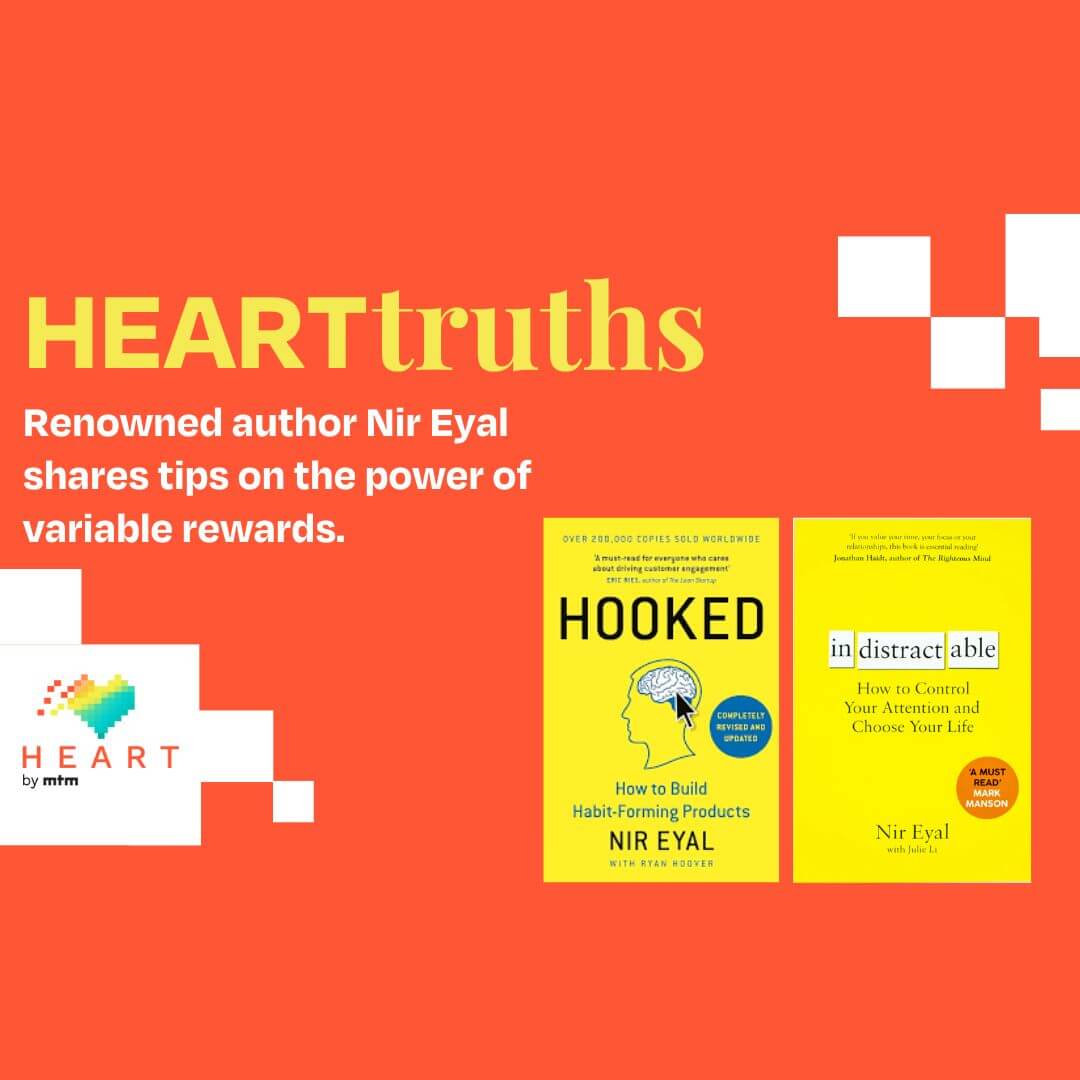MTM’s Jonathan Stone recently had an enlightening conversation with Nir Eyal, the acclaimed author of Hooked and Indistractible, and expert in behavioural design, about MTM’s HEART framework for healthy acquisition and retention. In this edition of HEARTtruths, we deep-dive into the power of variable rewards — the dopamine that keep customers engaged and sticky. Drawing from their conversation, we offer practical insights and tips to help you develop effective retention strategies that work.
The Power of Variable Rewards
One of the central themes in Nir Eyal’s book, Hooked, is the concept of variable rewards. This principle involves using unpredictable or intermittent reinforcement to keep users engaged and returning for more. Essentially, it creates a form of addiction where users continually seek the next reward, similar to likes, shares, or other forms of social validation.
The challenge for subscription brands is keeping customers happy over time and in a phenomenon known as hedonic adaption, our interest in things wanes over time. We need to keep the relationship alive and according to Nir, variable rewards is the solution.
This strategy is proving effective across various industries, particularly in categories such as FoodTech, TravelTech and FinTech, as discussed in the clips. The concept taps into the human affinity for mystery and surprise. When executed correctly, variable rewards can significantly enhance user acquisition and retention.
This doesn’t have to be monetary. Consider Airbnb, for example. This well-known platform for travel experiences has embraced variable rewards in its content strategy. Offering a range of potential experiences—from cosy cabins to luxurious villas—the platform keeps outcomes unpredictable, adding the allure of a ‘variable reward.’
How does content act as a variable reward? Think about the moment you open your app or check your email. The surprise of new, engaging content is like unwrapping a gift. The unpredictability—wondering what you’ll receive next—creates excitement. Whether it’s a discounted stay at a luxury location or a promo code for an experience on your next booking, this anticipation pulls you in.
Airbnb utilises this strategy by creating a sense of unpredictability through its dynamic content. The platform presents an array of travel experiences and stays, each with a unique touch. These vary from customer to customer based on their preferences, encouraging repeat usage and building deep loyalty without relying on conventional monetary rewards.
Variable rewards can also inspire ‘tribes’ or ‘communities’ of users who share similar interests. These groups are driven by a sense of belonging and identity. Offering non-monetary rewards, like exclusive content or early access to products and services, can fuel this tribe mentality and further drive engagement and loyalty. Educational content also serves as a form of variable reward, sparking curiosity and delivering genuinely helpful knowledge that keep users coming back for more.
Another compelling example of variable rewards can be seen in the gaming industry, particularly in how platforms like Xbox and PlayStation keep their users engaged. These companies offer a range of unpredictable rewards such as special in-game items, rare achievements, and surprise updates. Gamers are motivated to keep playing, consistently seeking rewards that enhance their experience. The beauty of this strategy lies in its blend of challenge, surprise and delight.
Variable rewards can significantly boost user engagement, but it’s vital to steer clear of manipulative tactics and excessive discounts. Nir also discusses the “Bed Bath and Beyond Effect,” where the business perpetually used enticing discounts to keep customers returning. However, customers came to expect these heavy discounts, making them reluctant to shop at full price. This ultimately contributed to the company’s bankruptcy.
Consistent discounting can devalue a product or service, taking focus away from the benefits and onto price, foster unsustainable expectations for continual price cuts, and strain a company’s financial health. Therefore, businesses must strike a balance in their strategies, ensuring they employ ethical and financially sound methods for incentivising bevahiours.
In conclusion, the power of variable rewards lies in their ability to positively and sustainably influence user behaviour. By creating unpredictability and using varied types of rewards, brands can forge deeper connections with users. As Nir Eyal suggests, mastering the balance between predictability and unpredictability is the key to successful user engagement.
The HEART framework provides valuable guidance for any brand looking to improve its habit-forming product design. Want to learn more? Reach out!
